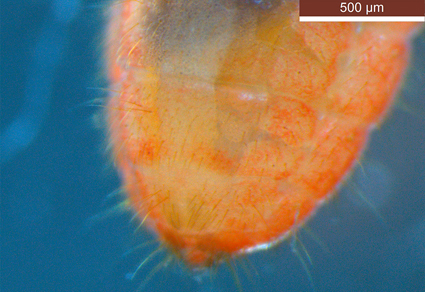Abstract
The immature stages of Gamostolus subantarcticus (Berg, 1883) (Hemiptera: Heteroptera: Aenictopecheidae) are described and compared. Main characteristics to distinguish the nymphs from adults are explained, among which we emphasize the relationship between antennal and rostral segments as important characters for their separation.
References
- Allué, C., Arranz, J.A., Bava, J.O., Beneitez, J.M., Collado, L. & García-López, J.M. (2010) Phytoclimatic characterization and cartography of subantarctic native forests in Isla Grande de Tierra del Fuego (Patagonia, Argentina). Forest Systems, 19 (2), 189–207. https://doi.org/10.5424/fs/2010192-01314
- Berg, C. (1883) Addenda et emendanda ad Hemiptera Argentina. Anales de la Sociedad Científica Argentina, 16, 105–125.
- China, W.E. (1962) Hemiptera-Heteroptera collected by the Royal Society Expedition to South Chile 1958-1959. Annals and Magazine of Natural History, Series 13, 5 (60), 705–723. https://doi.org/10.1080/00222936208651307
- Cobben, R.H. (1968) Evolutionary Trends in Heteroptera. Part I. Eggs, Architecture of the Shell, Gross Embrylology, and Eclosion. Centre for Agricultural Publishing and Documentation, Wageningen, 475 pp.
- Coscarón, M.C. (2017) A catalogue of the Heteroptera (Hemiptera) or true bugs from Argentina. Zootaxa, 4295 (1), 1–432. https://doi.org/10.11646/zootaxa.4295.1.1
- Fernandes, J.A.M. & Weirauch, C. (2015) The unique-headed bugs (Enicocephalomorpha). In: Panizzi, A.R. & Grazia, J. (Eds.), True bugs (Heteroptera) of the Neotropics. Springer, Dordrecht, pp. 91–98. https://doi.org/10.1007/978-94-017-9861-7_4
- Haglund, C.J.E. (1907) Die Hemipteren der Schwedischen Expedition nach den Magellansländern 1895–97. Svenska Expeditionen Till Magellansländerna, 9, 173–180.
- Henry, T.J. (2017) Biodiversity of Heteroptera. In: Foottit, R.G. & Adler, P.H. (Eds.), Insect Biodiversity: Science and Society. Vol. 1. 2nd Edition. John Wiley & Sons. New Jersey, pp. 279–335. https://doi.org/10.1002/9781118945568.ch10
- Kritsky, G. (1976) The Enicocephalidae (Hemiptera) in Illinois. Transactions Illinois State Academy of Science, 69, 192–193.
- Kritsky, G. (1977) Observations on the morphology and behavior of the Enicocephalidae (Hemiptera). Entomology News, 88, 105–110.
- Li, M., Tian, Y., Zhao, Y. & Bu, W. (2012) Higher level phylogeny and the first divergence time estimation of Heteroptera (Insecta: Hemiptera) based on multiple genes. PLoS One, 7 (2), e32152. https://doi.org/10.1371/journal.pone.0032152
- Mendonça Jr, M.S., Schwertner, C.F. & Grazia, J. (2009) Diversity of Pentatomoidea (Hemiptera) in riparian forests of south-ern Brazil: taller forests, more bugs. Revista Brasileira de Entomologia, 53, 121–127. https://doi.org/10.1590/S0085-56262009000100026
- Pereyra, H.A., Pancotto, V.A. & Coscarón, M.C. (2022) Aportes al conocimiento de la entomofauna patagónica: uso de hábitat de Gamostolus subantarcticus (Berg, 1883) (Hemiptera: Heteroptera: Aenictopecheidae). Revista Chilena de Entomología, 48 (4), 769–776. https://doi.org/10.35249/rche.48.4.22.12
- Schuh, R.T. (1970) Swarming in an undescribed enicocephalid (Hemiptera) from Costa Rica. Entomology News, 81, 66–68.
- Schuh, R.T. (1979) Review of evolutionary trends in Heteroptera. Part II. Mouthpart-structures and feeding strategies, by R. H. Cobben. Systematic Zoology, 28, 653–656. https://doi.org/10.2307/2412577
- Song, N. & Zhang, H. (2022) A comprehensive analysis of higher‐level phylogenetic relationships of Hemiptera based on transcriptome data. Journal of Systematics and Evolution, 61 (4), 572–586. https://doi.org/10.1111/jse.12855
- Štys, P. (1995) Dipsocoromorpha. In: Schuh, R.T. & Slater, J.A. (Eds.), True bugs of the world (Hemiptera: Heteroptera): classification and natural history. Comstock Publishing Associates, Ithaca, New York and Cornell University Press, London, pp. 74–83.
- Usinger, R.L. (1939) A new genus of Pacific Island Enicocephalidae with new species from the Hawaiian and Philippine Islands (Hemiptera). Proceedings of the Hawaiian Entomology Society, 10, 267–270.
- Usinger, R.L. (1945) Classification of the Enicocephalidae (Hemiptera, Reduvioidea). Annals of the Entomological Society of America, 38, 321–342. https://doi.org/10.1093/aesa/38.3.321
- Villiers, A. (1961) Un Henicocephalid myrmecophile de l’Afrique austral: Composederes stuckenbergi, n. sp. (Hemiptera). Annals of the Natal Museum, 15, 69.
- Weirauch, C., Schuh, R.T., Cassis, G. & Wheeler, W.C. (2019) Revisiting habitat and lifestyle transitions in Heteroptera (Insecta: Hemiptera): insights from a combined morphological and molecular phylogeny. Cladistics, 35 (1), 67–105. https://doi.org/10.1111/cla.12233
- Wygodzinsky, P.W. (1949) Redescription of “Gamostolus subantarcticus” (Berg, 1883) (Enicocephalidae, Hemiptera). Revista Brasileira de Biologia, 3, 353–358.
- Wygodzinsky, P.W. & Schmidt, K. (1991) Revision of the New World Enicocephalomorpha (Heteroptera). Bulletin of the American Museum of Natural History, 200, 1–265.


